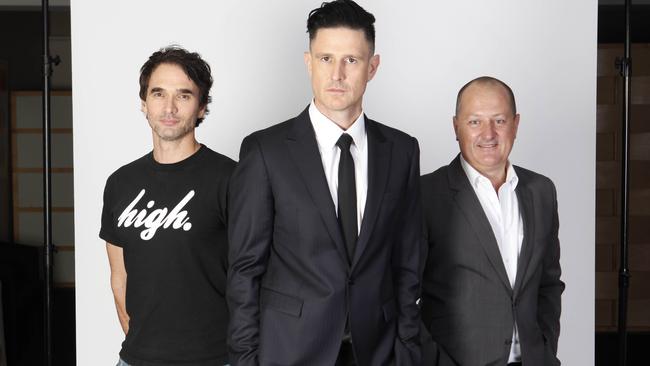Gruen Transfer’s Wil Anderson, Todd Sampson and Russel Howcroft return
The three Gruen-teers make a welcome return to the small screen to examine the world of advertising.

Happily for more than a million of us, the Rose d’Or-winning Gruen returns for a 12th incarnation in its seventh year, with another slight name change, promising to again be the show that analyses what most other programs are there to sell: advertising itself. And again its panel will run their amused and often perplexed eyes over spin, branding, positioning and image control, wherever they are found.
Comedian Wil Anderson continues as host, and Australia’s favourite advertising execs — loquacious Todd Sampson and even more talkative Russel Howcroft — also return. How they found the time is anyone’s guess. Sampson has been putting his well-known braininess to the test undergoing a radical mind makeover in a now six-part documentary series investigating the new science of brain plasticity, even putting his life on the line. Howcroft, once the chief executive of the Australia and New Zealand arm of global agency Young & Rubicam Brands, did the same thing simply by joining the then beleaguered Network Ten a couple of years ago — it seemed like professional suicide. But as executive general manager, he’s managed to turn it around too, albeit with shows of unparalleled banality. Marketing genius, indeed.
When The Gruen Transfer arrived it was hard to know what to expect. But as it turned out, produced by that TV genius Andrew Denton, a series about the discursive and emotive power of TV advertising was a great idea.
Denton’s trick was to get inside the complexities and trivialities of that mendacious industry using humour and a kind of forensic irony: second nature to his panel.
We may have had cheap clip show compilations of the funniest, daggiest and sexiest advertisements — a long-term staple of free-to-air vacuity — but no program has used humour to dismantle the thought processes of an industry that represents the sensibility of Australia’s changing consumers. The show gets us analysing the devices, the presentational tricks, the cross-cultural references or the clever recycling of earlier visual styles in commercial production. Mostly we just enjoy Sampson and Howcroft taking pot shots at each other and the cutting wit of Anderson, with his profound understanding of the increasingly busy audiovisual space in which we live.
Ironically, its return is especially welcome at a time when more and more of us are finding ways of avoiding TV advertising. For good reason. “Seeing a murder on television can help work off one’s antagonisms,” Alfred Hitchcock once famously said. “And if you haven’t any antagonisms, the commercials will give you some.” Despite the new disruptive technology, they now come at us at an alarming rate, seemingly without regulation, swelled with additional self-advertising and upcoming series promotions — these days programming is only there to fill time between ad breaks. Our lounge rooms are like duty-free shops.
Then there are the logos, idents, emblems, trademarks, promotions and domain names all over every program. The Guardian’s critic Mark Lawson calls it “huckstering punctuation”, these days more than ever affecting the shaping and pacing of programs themselves. “Midsomer Murders, for example, is often mocked for a murder rate increasingly implausible for its rural setting, but the creators have decided that the end-of-segment cliffhanger most likely to make an audience stay with the show is another slaying.”
There was a time when we quite liked commercials, especially when they were delivered live. Then there was a golden age of ads created by some of our more innovative film directors and cinematographers. But these days, intrusive, annoying and unwanted, most of it is third- class content forced down our throats. As Marshall McLuhan suggested, advertising remains devastatingly effective in making you sick, then selling you the cure. Over to the panel, please.
I urge you all to take a look at Mr Robot from writer and creator Sam Esmail, which celebrates the world of the vigilante hacker. Its first episode is one of the greatest pilots in recent times, with a wonderful orchestration of special effects, stunt work and fluid camera skills, a mesmerising piece of filmmaking echoing Scorsese and Fincher. There have been many TV shows and movies about hacking (you can forget Ten’s cliched and dull CSI: Cyber) but there’s been nothing quite like this series.
It stars Christian Slater in the title role of an anti-corporate anarchist leader who seeks to recruit young Elliot Alderson (Rami Malek), a socially awkward drug-addicted cybersecurity engineer (hacking being his only way of communicating with others) to his band of vigilante hackers known as F Society. As we like to say in TV, it’s a ripped-from-the-headlines conceit, given more immediacy by the recent violation of the infidelity website Ashley Madison.
The anonymous moral crusaders certainly resemble our bottled-up hero, who also, in what he sees as the greater good, treats privacy with contempt. In the pilot he takes down several rather morally disreputable types, unable to conceal his anger and contempt when he confronts them and informs them that he is ruining their lives. And in another narrative twist, he also proves that corporate undertakings around privacy and security are little more than hollow promises. (Ashley Madison’s former chief executive Noel Biderman bears a striking resemblance to one of the guys Elliot brings down, another corporate heavy oblivious to the consequences of hubris and, in his case, sexism and straight-out blokey arrogance.)
It’s taken a while but arts programming is making a belated return to Aunty and it’s been worth the wait. A specially commissioned one-hour series premieres this week, produced by six filmmaking teams spanning an eclectic range of subjects curated under the Artsville banner. Among the films are Stranded, the unlikely birth of the Australian punk music scene in Joh-Bjelke Petersen’s Brisbane, and The Diplomat, the Artist and the Suit, a look back at the work of the award-winning Australian architects Denton Corker Marshall, the designers of the new Australian Venice Biennale Pavilion.
It’s a terrific line-up but the first film — from the accomplished Essential Media, and directed with exquisite elegance by Emmy-nominated Sally Aitken (The Great Australian Race Riot) — is a corker. It’s narrated in wittily disdainful style by the great actress Kris McQuade as Aitken and her crew follow the creative process of Frank Gehry, arguably the world’s greatest living architect, as he creates his first building in Australia: the University of Technology Sydney’s new business school.
While it’s now claimed to be an architectural icon, the building in Sydney’s unfashionable southern end has many detractors, in a town that loves to eat artists.
The professionally cranky Mike Carlton, first in a chorus of naysayers, says of the crushed-looking building at the start of the film: “It’s vulgar; it’s showy; it screams out for attention like a child throwing a tantrum in a supermarket.” He continues: “It’s like a pile of old cardboard beer cartons left out in the rain for the rubbish man to collect.”
A perplexed engineer says of Gehry at the start of construction: “It’s just not going to be able to be done; he’s been bending the ruler too much.”
It’s all very amusing; as it turns out, so is Gehry himself, playful, polished and seriously cool. As he says of the carpers, “Anything that’s different to the way they did it before is always challenging.”
He’s rather droll about what passes for Sydney style, too. “It’s a city not too good with new stuff, much of its building is not architecture; with great pain they gave us the Opera House.” To show us the real thing, Aitken and her small crew travel the globe “to capture the physical experience of being adjacent to a whimsical, bold or simply jaw-dropping Gehry work”.
She subtly intercuts the story of the build with a witty and rather poetic biography of its maker, a resonant story of struggling outsider to beloved “it” artist. And she reveals the singular way in which Gehry’s rise to fame coalesces with a rising pop celebrity culture in the latter half of the 20th century.
Artsville: Getting Frank Gehry, Tuesday, ABC, 9.30pm
Gruen S7, Wednesday, ABC, 8.30pm
Mr Robot, Presto, streaming



